How US consumers spend their time online has shifted significantly in the past five years, according to Online Publishers Association (OPA) data presented in the Digital Marketing Factbook (Q4 2009) recently published by MarketingProfs.
The Digital Marketing Factbook, designed to be a comprehensive source of data and research for online marketers, includes chapters on email, search, and social media—with 144 pages of findings, including 110 charts and graphs from 60+ sources.
In 2004, US consumers spent 42% of their online time on communications-related activities such as reading and sending email, whereas now they spend only 27% of their time doing so, according to the OPA data cited in the Factbook.
What's filled the gap? Community-focused social networking sites such as Facebook, which now account for 13% of users' time, up from virtually nothing in 2004:
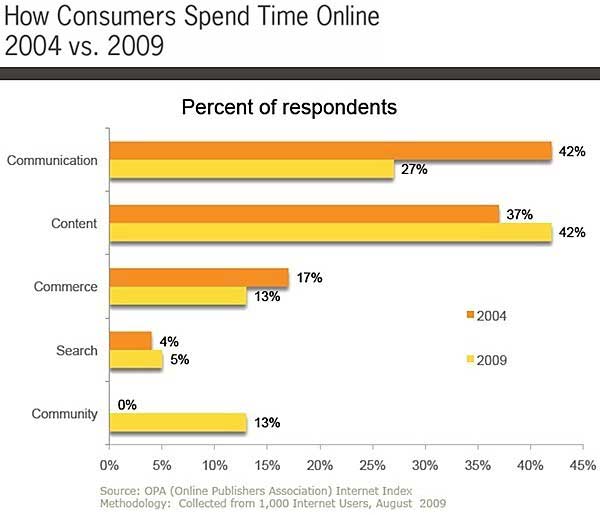
Key findings:
- In addition to devoting more of their online time to community sites, consumers today are spending more time on content sites and search, and less time on commerce sites, than they were in 2004.
- As for what specific activities US adults perform online today:
—90% send or read emails
—88% use search engines
—76% check the weather
—75% buy a product
—72% get news
—66% to make or buy a travel reservation
—60% to look for news or information about politics
(According to April 2009 data from the Pew Internet & American Life project included in the Factbook.)
Overview
The "Online Overview" that opens the Digital Marketing Factbook presents the information above, as well as data on Internet usage worldwide, typical marketing budgets, most successful and most used tactics, and marketing ROI—including, in all, 21 charts.
Following the overview are chapters on email, search, and social media marketing, all of which are sampled in this article.
"The Digital Marketing Factbook is more than just a compendium of charts. Marketers can use this information-packed resource to plan their online marketing campaigns and implement go-to-market tactics," said MarketingProfs President Roy Young.
"Armed with data regarding consumers’ online habits, preferences and inclinations, you’ll be able to best craft your digital message to reach loyal customers, reach new ones and retain them."
The Factbook is available for purchase by nonmembers for $199—or $119 for MarketingProfs Premium Members. Basic Members (just provide your email address to become one) can obtain a copy for $159 until Saturday, Oct. 31.
What Marketers Say
Senior marketers were asked which components of their current digital marketing programs—search, email, display advertising, social networking, and mobile advertising—delivered the best results. Only 11% cited social networking—an especially striking figure when you consider that consumers spend 13% of their online time on social networks, and this percentage is likely to grow.
Here's what senior marketers said of the results they get from components of their campaigns:

Key findings:
- Search marketing delivers the best results (33%); search and email still constitute the core of a solid online media plan.
- Mobile advertising... whoa.
Email Marketing
Nearly everyone uses email, and this medium is repeatedly ranked as one of the most cost-effective (and effective) forms of marketing.
The Email Marketing section of the Digital Marketing Factbook covers how, when, and why consumers and businesses use email, as well as providing marketing benchmarks, such as average open rates, that can help you judge your own efforts. In all, this section of the Factbook contains 18 charts.
What Consumers Say
Global email users were asked the following question: As a result of opening permission-based emails, how often do you normally take each of the following actions?
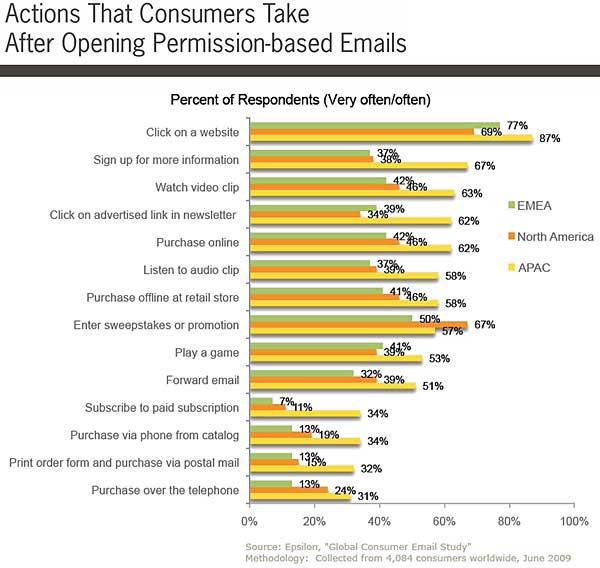
Key findings:
- Consumers in Asia appear more responsive to email offers than those in other regions, though a higher percent of consumers in North America would enter a sweepstakes or promotion.
- Asian consumers are also more likely to forward emails than consumers based elsewhere: 51% forward emails, compared with 39% of North Americans and 32% of Europeans.
- In another question, consumers were asked about what makes a subject line effective. The results showed that discount offers have universal appeal, but many subject lines are much more popular in Asia than in Europe or the United States (familiar brand names, new product announcements).
- European and North American consumers respond much the same to subject lines, although Europeans are more likely than Americans to find free product offers attractive (66% vs. 57%).
What Marketers Say
Looking at the most important email marketing initiatives that businesses consider implementing, we see that the top-ranked ones reflect a desire to improve relevancy. Some 66% of respondents are looking to increase the performance of their campaigns and 52% are looking to improve segmentation and targeting:
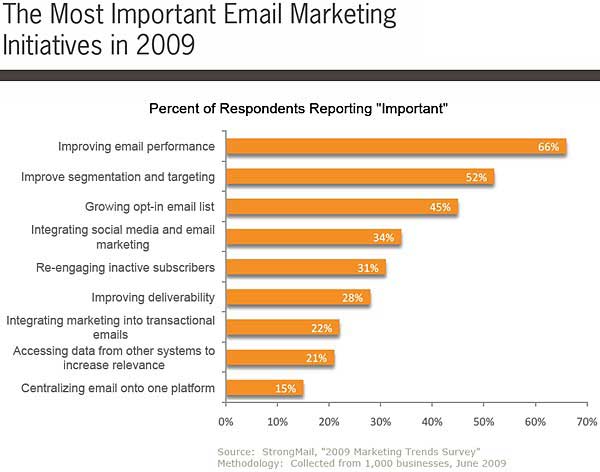
Other findings:
- According to a survey of 623 email marketers, almost 50% of respondents report that sending emails at midday (10 a.m. to 2 p.m.) is the best time of day to do so.
- The start of the business day (6 a.m. to 10 a.m.) is considered second best at 31.5%. Though every emailer should test for himself or herself what the best time of day is, this can help guide initial efforts.
Search Engine Marketing
The first stop for just about any type of information imaginable is an online search. This section of the Digital Marketing Factbook is full of information about how consumers seek information and how businesses are ensuring that their potential customers find it: e.g., which search engines are the favorites worldwide, how those favorites perform in different regions, and how to improve search marketing efforts.
This section of the Factbook contains 34 charts.
What Consumers Say
A survey of 320 Internet users found that search engines were the most valuable information source for someone making a purchasing decision:
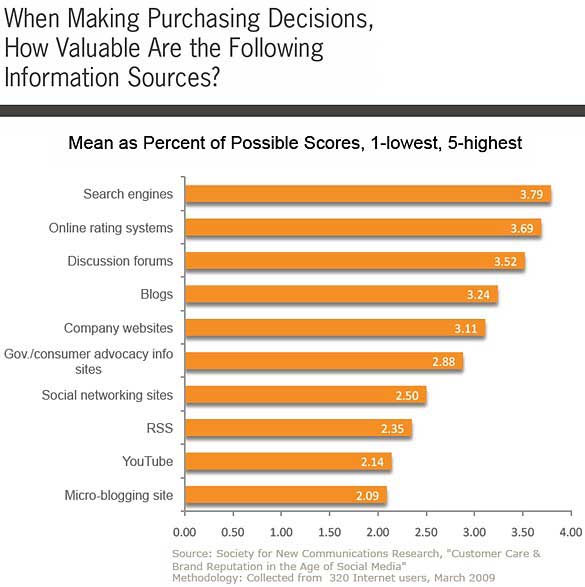
Key findings:
- Survey respondents ranked online rating systems second and discussion forums third.
- Consumers ranked social networking sites low among the options; it will be interesting to see whether consumers come to rely more on these sites in the months and years ahead.
Not all searches take place on search engines. Though not nearly as large as Google, a site like eBay hosts about as many monthly searches as Microsoft or Ask. With such volume, search marketers should be taking these sites into consideration when planning PPC strategies:

Other findings:
- Data from comScore suggests an interesting trend: a steadily increasing length in the phrases people use when searching for something. This means that the long tail of lesser-used, but more productive search phrases of 3+ words is growing. More exact searches mean more efficient targeting. More sophisticated usage as search becomes more mainstream is the most likely factor responsible.
- Hitwise data based on a sample of 10 million U.S. Internet users shows the same phenomenon: the length of search queries has increased over the past year. Searches of eight or more words increased the most (18%), although two-word searches made up the majority of searches, amounting to 23% of all queries in 2009. Understanding the middle of the long tail is a key part of maximizing the efficiency of a PPC campaign.
What Marketers Say
The search marketing firm SearchIgnite put together an aggregate analysis of its clients' activity in Q2 2008 compared with Q2 2009 to see the effects of the market downturn. What it found is that its clients have been able to get more PPC impressions and clicks while spending less.
For marketers with intact budgets, this is good news, because it means decreased competition and more cost-efficient PPC ads:

Social Media Marketing
The Social Media Marketing section of the Digital Marketing Factbook features the latest stats on usage of social media, including data for how usage differs across various demographics. Learn about who is reading blogs, chatting with friends or business contacts, putting up a blog, tweeting or creating a Facebook or MySpace page.
This section contains 37 charts.
What Consumers Say
Of the 418 social network users surveyed online by Knowledge Networks, almost one-quarter "sometimes" turn to social media for information on travel or travel services and "sometimes" got purchase advice on clothing or shoes, but very few do so "regularly."
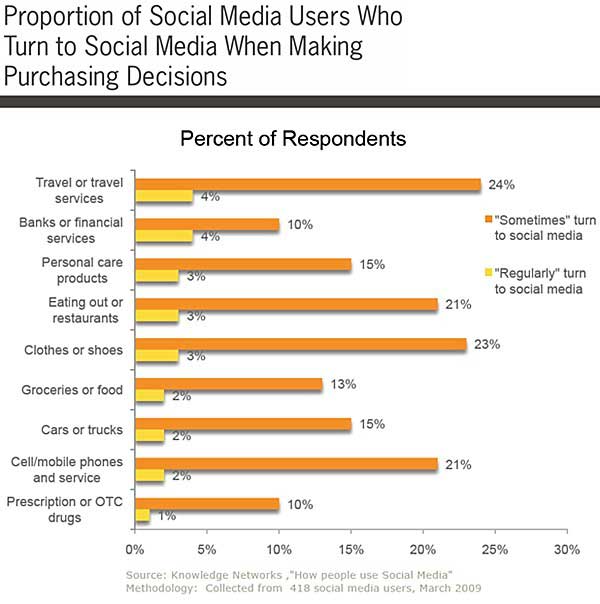
Other findings:
- According to BIGresearch's Simultaneous Media Usage Survey of 22,000 consumers, women are far more active on social networks than men, with the exception of the career-oriented LinkedIn.
- According to a study of 711 women social network users, nearly half of all social networking women belong to four or more networks. Based on focus groups conducted by ShesConnected, the primary reason given for joining multiple sites was "no one site meets all of my needs or interests." This insight may be particularly useful for marketers trying to help meet certain product-specific information needs.
- Some 57% of white-collar Baby Boomers report they use the networking site LinkedIn, while another 55% have a Facebook profile. This data comes from a survey of 1,660 business professionals age 45 to 63.
What Marketers Say
According to a survey of CMOs, 65% of companies use social networking sites for marketing. Those firms that do use social media do so toward a wide range of marketing objectives:
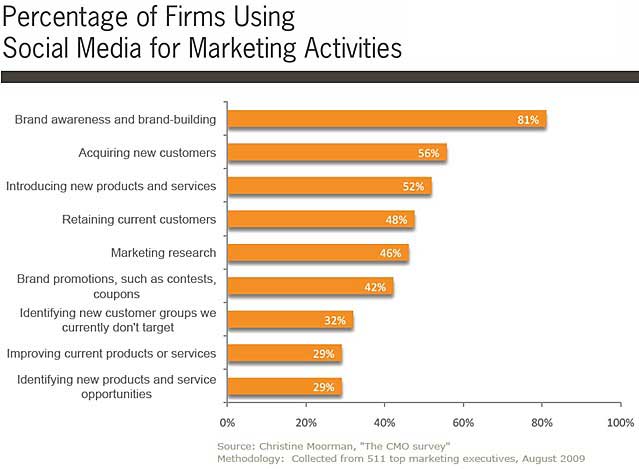
About the data: The Digital Marketing Factbook, designed to be a comprehensive source of data and research for online marketers, includes chapters on email, search, and social media—with 144 pages of findings, including 110 charts and graphs from 60+ sources.
The Factbook is available for purchase by nonmembers for $199—or $119 for MarketingProfs Premium Members. Basic Members (just provide your email address to become one) can obtain a copy for $159 until Saturday, Oct. 31.



